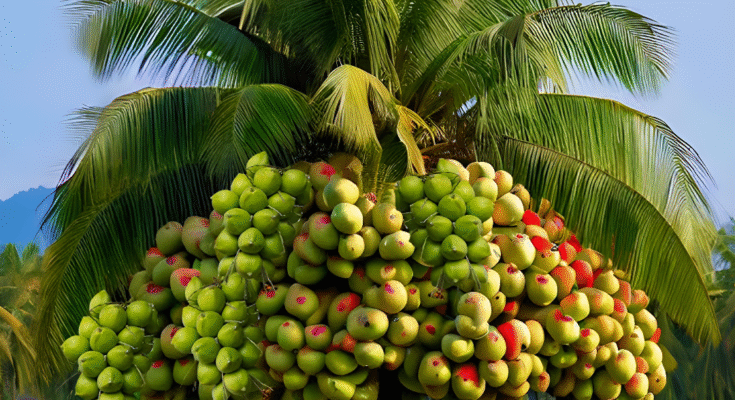Growing Coconut with Apples Using Secret Techniques
Growing coconuts and apples together might sound like something straight out of a horticulturist’s fantasy, but with some creativity, it’s possible to combine these two iconic fruits into a unique and productive agroforestry system. Using some lesser-known techniques — the so-called “secret techniques” — you can create a mutually supportive environment for both plants, boosting yields and sustainability in one innovative orchard.
Why Combine Coconuts and Apples?
At first glance, the idea of growing coconuts and apples together might seem improbable. After all, coconuts typically thrive in warm, tropical climates, while apples prefer temperate zones with a cool winter dormancy period. But recent research and practical experimentation have shown that by carefully controlling environmental conditions and selecting the right varieties, it is indeed possible to cultivate both trees in a single system.
Combining these crops has several advantages:
- Diverse Income Streams: You get two highly marketable products from the same plot.
- Increased Land Use Efficiency: You make better use of vertical space and light resources.
- Enhanced Soil Health: Different root systems and leaf litter compositions can improve soil structure and fertility.
The Secret Techniques Revealed
Now, let’s dive into the “secret” techniques that make this horticultural synergy possible.
1. Microclimate Manipulation
One of the biggest challenges is creating a suitable environment for both plants. Apples need some chill hours (cold temperatures) to trigger dormancy and ensure fruit set. Meanwhile, coconuts dislike frost and prefer consistently warm temperatures.
The Secret: Use coconut trees as partial windbreaks and canopy regulators for the apple trees. By planting coconut palms strategically around or between rows of dwarf apple varieties, you can:
- Moderate temperature extremes by reducing cold winds.
- Provide filtered sunlight, which helps protect the apple trees from excessive heat and sunburn in warmer climates.
Additionally, you can use low tunnels, frost covers, or even misting systems during critical months to create artificial chill periods for apples while protecting the coconuts from cold snaps.

2. Grafting and Rootstock Selection
Rootstocks play a key role in adapting fruit trees to specific soil and climate conditions.
The Secret: Select apple rootstocks that are tolerant of higher temperatures and less pronounced chilling. Some semi-dwarfing and dwarfing rootstocks (like M9 and M26) can tolerate warmer winters, especially when combined with microclimate management.
For coconuts, consider using hybrid varieties that mature quickly and are more resilient to variable conditions. Some dwarf coconut varieties can handle slightly cooler temperatures compared to their tall counterparts.
3. Soil Preparation and Mulching
Both coconuts and apples benefit from well-drained, fertile soils, but they have different preferences regarding pH and nutrient balance.
The Secret: Develop a soil management plan that layers organic matter and maintains soil biodiversity. Use:
- Coconut husk mulch: It retains moisture, suppresses weeds, and slowly decomposes to enrich the soil.
- Apple prunings: These can be chipped and composted to create high-carbon mulch, balancing the high potassium levels that coconut palms often bring.
Adding biochar (charred organic material) can further enhance soil structure and microbial life, benefiting both tree species.

4. Integrated Pest Management (IPM)
Pests can threaten both crops — apple trees are susceptible to codling moths and aphids, while coconuts can attract rhinoceros beetles and mites.
The Secret: Use companion planting with flowering plants like marigolds, lemongrass, or nasturtiums between the trees. These plants attract beneficial insects like ladybugs, predatory wasps, and lacewings that naturally keep pests under control.
Neem oil sprays and other organic treatments can be used as needed. Regular monitoring, sticky traps, and pruning also play crucial roles in keeping the orchard healthy.
5. Water Management
Coconuts love consistent moisture but can suffer in waterlogged soils. Apples generally prefer more moderate irrigation and can be prone to root rot if overwatered.
The Secret: Install a drip irrigation system with adjustable zones. Place moisture sensors in the root zones of both tree types to fine-tune watering. Coconut trees’ deep roots help draw up water from lower soil layers, while apple trees’ shallower roots benefit from consistent surface moisture. This complementary system reduces water stress for both crops.

Conclusion
Growing coconuts with apples is more than a horticultural curiosity — it’s a creative, sustainable, and potentially profitable agroforestry venture. By using these secret techniques — microclimate manipulation, grafting, soil preparation, integrated pest management, and smart water management — you can turn your orchard into a productive, diverse, and resilient system.
The next time you think of apples and coconuts, don’t imagine them as separate worlds — envision them as partners in a dynamic agricultural dance that celebrates innovation and harmony with nature. With patience, observation, and the right strategies, you can make the impossible possible and create a truly unique orchard that thrives in both yield and ecological health. Happy planting!



